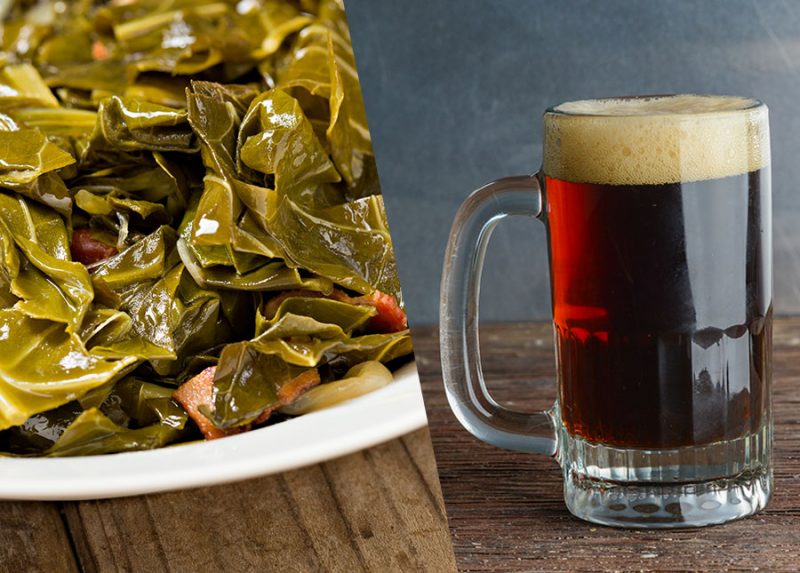
Any self-respecting person raised in the South has surely eaten collards, if not gone a step further in spending hours over a pot making these delicious braised greens. Collard greens, like many cruciferous veggies, grow well in the winter (depending on where you live), which is why they are traditional New Year’s Day fare. According to popular folklore, eating your dose of greens on New Year’s Day is one way to ensure good fortune in the year ahead. The greens are meant to resemble money—folded bills, specifically. So, take these and stuff them in your pocket for 2018!
Collard greens are more commonly prepared cooked than raw, in large part due to the bitter nature of the greens. Cooking them down in your favorite stock or vinegar is one way to cook bitterness out while also imparting a dynamic savory component to these fan-like beauties. They can certainly be made vegetarian without the use of pork fat, but in staying true to tradition, I say get your hands on a ham hock if you can!
Southern-style Collard Greens
Ingredients:
- 2–3 bunches collard greens, washed and stemmed
- 1 pack of ham hocks (generally two per pack)
- 2 cups chicken or veggie stock
- 1/4–1/2 cup apple cider vinegar
- 2–3 cloves garlic, minced
- 2–5 slices of bacon (or ham hocks)
- 1 Tbsp. dried flaked chiles (red pepper or aleppos work great)
- 2 Tbsp. olive oil
- Salt and pepper to taste
Directions:
Step 1: After you have washed and stemmed the collard greens, cut them into strips. While you’re chopping the greens, pour the oil into a cast-iron Dutch oven on medium to high heat with the minced garlic and ham hocks. Allow the minced garlic and ham hocks to cook until aromatic and slightly browned. Add the ham hocks and sauté in oil and garlic until lightly browned.
Step 2: Add the stock to the bottom of the skillet so that it may simmer and soak up the flavor of the ham hocks. Slowly add the greens to the pot. The greens will reduce significantly in size as they wilt, so a good technique is adding a little, letting it reduce, and then adding more until you’re done.
Step 3: After you add the greens, leave them to braise in the stock and add apple cider vinegar, salt and pepper. If you have the time, allow the greens to cook for 1–2 hours on low heat. Add more stock to the greens as it evaporates if the greens appear dry.
Step 4: Best served hot with a splash of pepper vinegar.

Pairing Suggestions
Try pairing your collard greens with a dark lager, such as a German schwarzbier or dark American lager. The clean yeast character of a lager will allow the savory aspects of the greens to stand out while the moderate hop bitterness will complement the acidity of the greens. The crisp characteristics of a dark lager on the palate along with the roasted barley will cut straight through the pork fat, too, making for a well-balanced sensory experience.
Schwarzbier Homebrew Recipe
If you’re planning ahead, brew this schwarzbier recipe, “Doktor Schnurrbart Schwarzbier” to go with your collard greens.
Specs:
- Original Gravity: 1.061
- ABV: 4.6%
- IBU: 26
- SRM: 23
Ingredients for 6 gallons (23 L):
- 6.5 lb. (2.9 kg) amber malt extract
- 1.5 lb. (0.68 kg) dark crystal malt
- 6.0 oz. (170 g) black patent malt
- 2.0 oz. (56 g) Spalt hops, 4% a.a. (90 min.)
- Bavarian lager yeast
Directions:
Once the wort is near or below 60°F (16°C), pitch yeast. Lager fermentation requires the wort to be held around 50°F (10°C) while in primary. Near the end of fermentation, raise the temperature to around 60–65°F (16–18°C) for a diacetyl rest of 2–3 days. Then transfer the beer to a secondary vessel and lower the temperature to 35–40°F (2–4°C) for six weeks of cold lagering.
If naturally carbonating, raise the temperature to around 60–65°F (16–18°C) to promote yeast activity during bottle conditioning. Otherwise force carbonate the cold beer to approximately 2.5 volumes (5 g/L) of CO2.
* * *
Hailing from the South, Millie Shamburger has developed an affinity for the beer industry and all the shiny things that come with it. When not exploring beer, Millie is in the kitchen, enjoying the outdoors, and wearing out her dancing shoes.
The post The Homebrewer’s Table: Collard Greens with Dark Lager appeared first on American Homebrewers Association.

![]()

